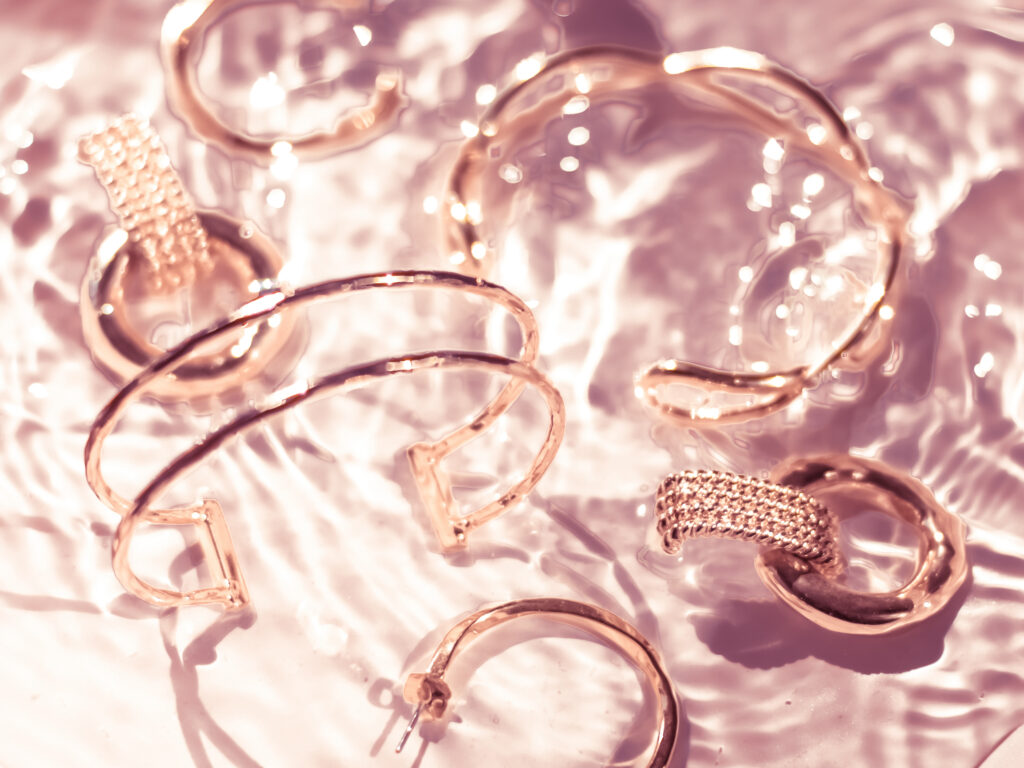Rose gold is an attractive and relatively modern variant of regular gold that has a little copper mixed in, but can you wear it in the shower?
Most gold jewelry can be worn in the shower, and that includes rose gold. However, doing so can tarnish the metal and reduce its shine, and any products you use may have an adverse impact on the jewelry. Although, rose gold is less susceptible to tarnishing than yellow or white gold.

Read on to learn more about rose gold, where it came from, and why it’s so popular today.
The Attractive Alternative To Tradition
Today, rose gold can be seen everywhere from jewelry to phones, and from kitchen appliances to cars. It’s as popular a color or effect as it is an option for rings, necklaces, bracelets, and pretty much any other kind of jewelry.
However, before the tail end of the 19th century, rose gold didn’t even exist. It was created by Carl Faberge, a legendary jeweler and smith who is best known for the production of ‘Faberge eggs’.
These eggs were dramatically luxurious creations, heavily adorned with fine gemstones and made from the most precious of metals. In making them truly unique, Carl Faberge experimented with different ‘blends’ of gold, ultimately creating rose gold.
This variant is created by mixing gold, usually 18K gold, with copper, and a little silver, producing the reddish hue that rose gold is so well known for. However, this practice ensures that rose gold can never be 24K, or ‘pure’ gold.
When mixed correctly, rose gold is an attractive, resilient, and more durable alternative to regular, yellow gold. It isn’t quite as popular as white gold, but it is a fair contender, owing chiefly to its beneficial attributes.
As it has a presence of tough copper within it, rose gold is naturally more durable and resilient to aging. It also won’t tarnish as fast or as heavily as yellow gold, and over time it will simply darken slightly, with the copper simply maturing as time goes on.
While regular gold rings have been a tradition for thousands of years, rose gold is rising up in the ranks of popularity these days, effortlessly overtaking it. It’s a much more unique, feminine, and graceful alternative to the outdated yellow gold that we all know.
How To Care For Your Gold
If you’re going to go out and spend thousands of dollars on fine gold jewelry, you’re going to want to protect it. To that end, there are several rules that you should follow when deciding whether or not to keep that ring on your finger, for example.
Admittedly, we’ve just explained that rose gold is more durable than regular gold. However, that doesn’t mean it’s impervious to damage, and it can still be impacted by adverse conditions.
For example, while you can wear rose gold in the shower, you shouldn’t make it a regular practice to do so. Furthermore, if you’re using cleaning products while in the shower, you should make sure they’re as mild as possible, to avoid tarnishing the ring or gemstone.
If you’re going to work with your hands, cook, do some gardening, or play sports, you should consider removing your rose gold ring entirely. It could fall off, given the right circumstances, or it could become damaged in some way.
Over time, jewelry will almost certainly tarnish – that’s just a fact of life. It’s the result of the oils on your skin, the weather, pollutants, or just the effects of time, but almost every item of jewelry you own will age in some way.
However, there are fairly simple ways to restore jewelry, such as rubbing it with a special ‘jewelry cloth’ to improve its shine. It’s perfectly acceptable to soak the jewelry in warm, soapy water beforehand, provided the soap in question is as mild as can be.
Ultimately, even lasting damage can be repaired, regardless of whether your jewelry is made from rose gold, white gold, or standard, yellow gold. It can be replated, dents can be beaten out, and scratches can be smoothed over to create a shining finish once again.
Although, if you want to avoid those extra costs altogether, you should follow the steps laid out here to reduce the chances of damaging your jewelry to start with. We published another article discussing how to take care of fine diamonds, particularly those mounted on rings, if you’d like to learn more.
